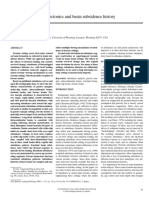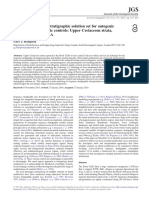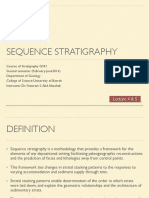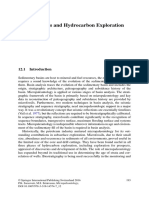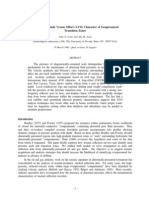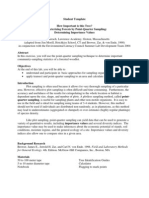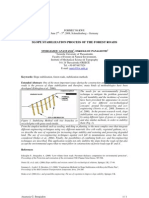The 'Aggradational Highstand Systems Tract' (AHST) : A Peculiar Feature of Highly-Supplied Growth Fault-Bounded Basin Fills
The 'Aggradational Highstand Systems Tract' (AHST) : A Peculiar Feature of Highly-Supplied Growth Fault-Bounded Basin Fills
Uploaded by
marco_dispenaCopyright:
Available Formats
The 'Aggradational Highstand Systems Tract' (AHST) : A Peculiar Feature of Highly-Supplied Growth Fault-Bounded Basin Fills
The 'Aggradational Highstand Systems Tract' (AHST) : A Peculiar Feature of Highly-Supplied Growth Fault-Bounded Basin Fills
Uploaded by
marco_dispenaOriginal Title
Copyright
Available Formats
Share this document
Did you find this document useful?
Is this content inappropriate?
Copyright:
Available Formats
The 'Aggradational Highstand Systems Tract' (AHST) : A Peculiar Feature of Highly-Supplied Growth Fault-Bounded Basin Fills
The 'Aggradational Highstand Systems Tract' (AHST) : A Peculiar Feature of Highly-Supplied Growth Fault-Bounded Basin Fills
Uploaded by
marco_dispenaCopyright:
Available Formats
GeoActa, vol. 6, 2007, pp.
83-89, Bologna
The `aggradational highstand systems tract' (AHST): a peculiar feature of highly-supplied growth faultbounded basin fills
MASSIMO ZECCHIN
Istituto Nazionale di Oceanografia e di Geofisica Sperimentale OGS, Borgo Grotta Gigante 42/c, 34010 Sgonico (TS), Italy. E-mail address: mzecchin@ogs.trieste.it
Abstract
Normal fault-bounded basins commonly show a sequence-stratigraphic architecture that is deviated from classic models derived from passive margins. In particular, depositional sequences containing well developed shallow-marine, mostly aggradational intervals resting on back-barrier to shallow-marine transgressive intervals are common in highly-supplied growth fault-bounded basins. These aggradational intervals have been called `aggradational highstand systems tract' (AHST), and result from the balance between the rate of sediment supply and the rate of creation of accommodation following a transgression. A distinct maximum flooding surface is not recognizable at the base of the AHST, which can be considered as an extremely expanded maximum flooding zone. The development of this type of sequence is favoured in contexts characterized by a relatively rapid and constant fault-controlled subsidence and a high rate of sediment supply that just compensates the rate of creation of accommodation. A rapid change in the tectonic regime may lead to abrupt interruption of sedimentation and to the formation of main unconformities. For the observed linkage between depositional sequence architecture and changes in the tectonic regime, AHST recognition may be useful to discriminate between a dominant tectonic or eustatic control in sequence development. Keywords: Aggradational highstand systems tract, Zinga-type sequence, Sequence stratigraphy, Growth faultbounded basins, Tectonic control
Introduction
Recent studies (e.g. Gawthorpe et al., 1994, 2003; Zecchin et al., 2006) demonstrate that the stratal architecture of deposits accumulated in growth fault-bounded basins may be very different from that proposed by classic sequence-stratigraphic models developed for passive continental margins (e.g. Posamentier et al., 1988; Posamentier and Vail, 1988) (Figs. 1 and 2). In particular, the interplay between fault-controlled subsidence, sediment supply and local physiography may produce sequences showing a `distorted' architecture because of an extremely variable development of systems tracts, the characteristics of which can be deviated with respect to the norm (Zecchin et al., 2006) (Fig. 2). Due to high variability of depositional conditions in these settings, the individual contribution of eustatic and tectonic changes on sequence development may be particularly difficult to distinguish, i.e. the distinction between sequences generated by either
eustatic changes superposed on tectonics or tectonic changes only is not easy. New tools are therefore needed to better understand the mechanisms controlling the development of sequences and individual systems tracts within normal fault-bounded basins. A peculiar characteristic of relatively highlysupplied, normal fault-bounded basins is the common occurrence of successions characterized by an aggradational stacking pattern, as illustrated by several authors through field and subsurface data (e.g. Gawthorpe et al., 1994; Davies et al., 2000; Hodgetts et al., 2001; Young et al., 2002; Ambrose et al., 2003; Zecchin et al., 2004; Jackson et al., 2005; Morris et al., 2006; Zecchin et al., 2006), as well as by numerical modelling (Gawthorpe et al., 2003; Ritchie et al., 2004). The present study is aimed to demonstrate how sedimentary successions containing aggradational intervals may contribute to recognize the main factors controlling the deposition in growth faultbounded basins.
83
Massimo Zecchin
Fig. 1 - Basic sequence-stratigraphic model for passive continental margins. A fourfold subdivision of systems tracts is adopted. FRST: forced regressive systems tract; HPW: healing phase wedge; HST: highstand systems tract; LST: lowstand systems tract; TST: transgressive systems tract. (Modified from Plint and Nummedal, 2000).
Fig. 2 - Examples of sequences deposited in fault-bounded basins. (A) Hypothetical growth-faulted margin. Note the architectural variability between hanging-wall and footwall blocks due to syndepositional fault activity (modified from Vail and Wornardt, 1990). (B) Sequence developed in the immediate hanging-wall of a normal fault segment. In this case, fault controlled subsidence prevents relative sea-level falls (modified from Gawthorpe et al., 1994).
84
The `aggradational highstand systems tract' (AHST): a peculiar feature of highly-supplied growth fault-bounded basin fills
Fig. 3 - Schematic log displaying typical architecture of a Zinga-type sequence and the characteristic field appearance of the AHST (based on examples from the Crotone Basin illustrated by Zecchin et al., 2004, 2006). The Zinga-type sequence shows a dominant aggradational component, the development of which is controlled mainly by fault-controlled subsidence (see text). Note small-scale cyclicity in the AHST.
The AHST and the Zinga-type sequence
The term `aggradational highstand systems tract' (AHST) has been introduced by Zecchin et al. (2006) to indicate markedly aggradational successions deposited in the immediate hangingwall of an half-graben basin. In particular, the AHST is defined as `an aggradational package of small-scale cycles deposited above a transgressive surface or a relatively thick retrogradational succession interpreted as a TST' (Zecchin et al., 2006). The key characteristics of the AHST are (Figs. 3 and 4A): 1- a dominant aggradational stacking pattern of the succession, with no or very little progradation in its upper part; 2- stratigraphic position above the TST or a transgressive surface, and below the upper sequence boundary or forced regressive deposits; 3- lack of a distinct maximum flooding surface at its base; consequently, the TST grades upward into the AHST. For its characteristics, therefore, the AHST may be considered as a highly expanded maximum
flooding zone, the development of which results from balanced conditions between accommodation and sediment supply during a climax phase of fault-controlled subsidence (i.e., long-term A/ S=1; Zecchin, 2007). Depositional sequences containing AHST are characterized by a peculiar stratal architecture that has been described by Zecchin et al. (2003, 2004, 2006) in the lower Pliocene Zinga 2 and Zinga 3 stratal units of the Crotone Basin, southern Italy. Accordingly, this type of sequence is here called `Zinga-type sequence' (Figs. 3 and 4A). A generic Zinga-type sequence (typically of hectometric scale) is bounded by major unconformities (sequence boundaries) linked to tectonic deformation and uplift. It consists of a TST mostly composed of lagoonal/bay and shallow-marine sediments, showing a retrogradational stacking pattern with an aggradational component that increases upward, and of a mostly aggradational package composed of shallow-marine deposits, the AHST (Figs. 3 and 4A). Thin forced
85
Massimo Zecchin
Fig. 4 - Different types of sequence architecture in growth fault-bounded basins. The same initiation of basin development and a relatively high sediment supply are assumed in all cases. Basins are mostly footwall sourced. (A) Architecture and indicative relative sea-level curve for the Zinga-type sequence (modified from Zecchin et al., 2006). This sequence is characterized by a dominant retrogradational to aggradational stacking pattern, the latter called `aggradational highstand systems tract' (AHST). Note the more common architecture in the footwall (TST+HST). (B) and (C) Sequence architecture and indicative relative sea-level curves in the hypothesis of a sinusoidal eustatic curve superposed on a constant fault-controlled subsidence (partially based on cases illustrated by Gawthorpe et al., 1994 and Ritchie et al., 2004). In the case of a rate of eustatic fall outpacing that of tectonic subsidence (case B), a common sequence architecture, including LST, TST, HST, and FRST, is developed. In contrast, if the rate of eustatic fall is unable to create relative a sea-level lowering (case C), both FRST and LST are absent, and a SMST is developed between HST and TST. Note the presence of a (type-1) sequence boundary in the footwall in case C, due to either local significantly lower rates of subsidence or to uplift.
86
The `aggradational highstand systems tract' (AHST): a peculiar feature of highly-supplied growth fault-bounded basin fills
regressive shoreface strata may be present near the top of the sequence, whereas the LST (sensu Hunt and Tucker, 1992, 1995; Helland-Hansen and Gjelberg, 1994; Plint and Nummedal, 2000) is commonly absent, or possibly represented by thin (meter-scale) fluvial deposits (Figs. 3 and 4A). However, local recognition of bidirectional palaeocurrent patterns within basal fluvial deposits suggests a tidal influence and deposition during the earliest transgressive phase (Zecchin et al., 2004 - Figs. 3 and 4A). In a few peculiar cases, the TST is not recognizable, and the sequence is mostly aggradational (Zecchin et al., 2006). Although stratigraphic architecture showing a marked aggradational component has been recognized in several tectonic settings, this feature is common in successions deposited within growth fault-bounded basins, and is controlled mainly by the interplay between tectonics and sediment supply (Zecchin et al., 2004, 2006 - Fig. 4A).
The key factors controlling AHST architecture
The illustrated characteristics aid to distinguish the AHST from other mostly aggradational systems tracts, i.e. the shelf margin systems tract or SMST (Van Wagoner et al., 1988). In fact, the SMST is placed between the HST (below) and the TST (above) (Figs. 2B and 4C), whereas the AHST lies between the TST (below) and the overlying sequence boundary (Fig. 4A), and occupies the same position as the HST. Relatively high sediment supply and high subsidence settings provide an ideal situation for the accumulation of the AHST. Although these conditions can be reached in various tectonic settings, they are common in normal fault-bounded basins. It is predictable that the AHST passes laterally into a typical HST toward the fault tips, where the subsidence rate is overwhelmed by the rate of sediment supply (Zecchin et al., 2006). Moreover, if block rotation linked to basin bounding fault activity is significant, a lateral variation of the architecture of the basin fill may result from the immediate hanging-wall to the hanging-wall dip slope (e.g. Gawthorpe et al., 2003). The development of the AHST is unlikely in the hypothesis of an eustatic control on sequences and a roughly sinusoidal sea-level curve, leading to progressively decreasing accommodation rates during late highstand phases. In fact, in these conditions the rate of sediment supply is unable to
balance the variable rates of creation and destruction of accommodation; therefore, a classic sequence containing a typical HST, with an aggradational to progradational trend, is more likely produced in these settings (Fig. 4B). The relatively constant depositional conditions required for the accumulation of the AHST, therefore, suggest a tectonic control on accommodation development. In particular, the formation of the AHST is favoured by the activity of normal faults leading to long-term constant rates of creation of accommodation during a climax phase of basin development, whereas possible superposed eustatic variations may lead to a smaller-scale cyclicity (Zecchin, 2005, 2007 - Fig. 3). An abrupt change in tectonic regime, leading to a sudden interruption of the relatively constant fault-controlled subsidence and to a generalized uplift (e.g. an abrupt change from an extensional/ transtensional to a compressional/transpressional regime), may be responsible for the deposition of thin forced regressive deposits and/or for the formation of an unconformity (the sequence boundary) directly above the AHST (Figs. 3 and 4A). Aggrading successions have been illustrated in several normal fault-controlled settings (e.g. Gawthorpe et al., 1994; Davies et al., 2000; Hodgetts et al., 2001; Young et al., 2002; Ambrose et al., 2003; Zecchin et al., 2004, 2006; Jackson et al., 2005; Morris et al., 2006), although a variability of their characteristics is recognizable. A sequence architecture very similar to that of Zinga-type sequence is illustrated by Davies et al. (2000) in the Jurassic Tarbert Formation (North Sea). Here, bay sediments overlain by aggrading shoreface deposits are common within fault-controlled depocentres. Progradation is recorded only in the upper part of the Tarbert Formation (Davies et al., 2000). In contrast, the aggradational intervals of the Champion field shallowmarine deposits (Brunei Darussalam, South China Sea) commonly overlie progradational packages and may pass upward into retrogradational deposits (Hodgetts et al., 2001). This case suggests the presence of potential type-2 sequence boundaries in the Champion field deposits (Hodgetts et al., 2001); therefore, the aggradational intervals occupy the same position as the SMST within the sequences. Considering only the case of normal faultbounded basin fills, significantly different depositional conditions favour the development of
87
Massimo Zecchin
either a sequence containing a SMST or a Zingatype sequence (Fig. 4A,C). Fault-controlled subsidence near the center of normal fault segments has the effect to attenuate or cancel base-level lowering; as a consequence, type-2 sequence boundaries and SMSTs are common within normal fault-bounded basins (e.g. Gawthorpe et al., 1994; Hodgetts et al., 2001 - Figs. 2B and 4C). In contrast, as illustrated by the Crotone examples (Zecchin et al., 2006), if phases of relatively constant fault-controlled subsidence balanced by sediment supply are interrupted by relatively rapid changes in the tectonic regime, leading to abrupt base-level lowering, the development of a Zingatype sequence is likely (Fig. 4A). However, if changes in the tectonic regime are more gradual, the resulting sequence architecture may simulate that of a classic sequence.
ing-wall locations creates a local sediment trapping area in the fault-bounded basin. Its relatively limited extent and the consequent limited sediment dispersal do not favours the autoretreat. This makes possible to reach a long-term equilibrium between the rate of creation of accommodation and the sediment supply rate (A/S=1) within the normal fault-controlled basin, and thus generation of the AHST.
Conclusions
The above discussion suggests some considerations. Highly aggradational successions, if not limited to turnaround intervals between transgressive and regressive trends and vice versa (i.e., maximum flooding zones and SMSTs), but forming a significant part of the sequence (Fig. 4A), are unlikely related to gradual eustatic sea-level changes. A long-term tectonic control better justifies stratal architecture of the Zinga-type sequence, and therefore the formation of the AHST. As the development of the AHST is well explained by long-term constant rates of creation of accommodation balanced by sediment supply (A/ S=1), condition that is frequently produced in settings dominated by fault-controlled subsidence, the AHST, and in general the Zinga-type sequence architecture, may represent an useful tool to recognize a dominant tectonic control on sequence development. In particular, the described stratal architecture is indicative of both rapid changes in the tectonic regime and sediment entrapment in a basin of relatively limited extent, as the clastic sediment supply is not totally dispersed in a wide shelf and is able to reach a local longterm equilibrium with rising relative sea-level. Eustatic sea-level changes, instead, are thought to be mostly responsible for the generation of a smaller-scale cyclicity.
Acknowledgements I thank Editor Alessandro Amorosi and an anonymous reviewer for their careful reviews and comments.
The problem of the autoretreat
Vertically directed shoreline trajectories (Helland-Hansen and Martinsen, 1996) are thought to be unstable in typical wide, clastic shelf settings, because commonly sediment supply no longer balances a rising relative sea-level, and shoreline autoretreat may occur (Muto and Steel, 1992, 1997; Muto, 2001). The autoretreat is defined as an inevitable landward retreat of a shoreline under conditions of constant rate of relative sea-level rise and without change in other variables, and is caused by the inability of sediment supply to fill the increasing shelf area during normal regressions (Muto and Steel, 1992, 1997). Consequently, a change of the shoreline trajectory from regression to transgression occurs. Muto and Steel (1997) have shown that the autoretreat becomes less effective if the rate of creation of accommodation is low and/or the rate of sediment supply high. The abundance of aggradational successions within normal fault-bounded basins, however, demonstrates that sediment supply can reach long-term equilibrium with increasing accommodation in these settings. The sinking effect of fault-controlled subsidence in immediate hang-
References
AMBROSE W.A., WAWRZYNIEC T.F., FOUAD K., TALUKDAR S.C., JONES R.H., JENNETTE D.C., HOLTZ M.H., SAKURAI S., DUTTON S.P., DUNLAP D.B., GUEVARA E.H., MENESES-ROCHA J., LUGO J., AGUILERA L., BERLANGA J., MIRANDA L., RUIZ MORALES J., ROJAS R. and SOLIS H., 2003. Geologic framework of upper Miocene and Pliocene gas plays of the Macuspana Basin,
88
The `aggradational highstand systems tract' (AHST): a peculiar feature of highly-supplied growth fault-bounded basin fills
southern Mexico. American Association of Petroleum Geologists Bulletin 87, 1411-1435. DAVIES S.J., DAWERS N.H., MCLEOD A.E., and UNDERHILL J.R., 2000. The structural and sedimentological evolution of early synrift successions: The Middle Jurassic Tarbert Formation, North Sea. Basin Research 12, 343-365. GAWTHORPE R.L., FRASER A.J., and COLLIER R.E.L., 1994. Sequence stratigraphy in active extensional basins: implications for the interpretation of ancient basin-fills. Marine and Petroleum Geology 11, 642-658. GAWTHORPE R.L., HARDY S., and RITCHIE B., 2003. Numerical modelling of depositional sequences in half-graben rift basins. Sedimentology 50, 169-185. HELLAND-HANSEN W. and GJELBERG J., 1994. Conceptual basis and variability in sequence stratigraphy: a different perspective. Sedimentary Geology 92, 31-52. HELLAND-HANSEN W., and MARTINSEN O.J., 1996. Shoreline trajectories and sequences: description of variable depositionaldip scenarios. Journal of Sedimentary Research 66, 670-688. HODGETTS D., IMBER J., CHILDS C., FLINT S., HOWELL J., KAVANAGH J., NELL P. and WALSH J., 2001. Sequence stratigraphic response to shoreline-perpendicular growth faulting in shallow marine reservoirs of the Champion field, offshore Brunei Darussalam, South China Sea. American Association of Petroleum Geologists Bulletin 85, 433-457. HUNT D. and TUCKER M.E., 1992. Stranded parasequences and the forced regressive wedge systems tract: deposition during base-level fall. Sedimentary Geology 81, 1-9. HUNT D. and TUCKER M.E., 1995. Stranded parasequences and the forced regressive wedge systems tract: deposition during base-level fall - reply. Sedimentary Geology 95, 147-160. JACKSON C.A.L., GAWTHORPE R.L., CARR I.D. and SHARP I.R., 2005. Normal faulting as a control on the stratigraphic development of shallow marine syn-rift sequences: the Nukhul and Lower Rudeis Formations, Hammam Faraun fault block, Suez Rift, Egypt. Sedimentology 52, 313-338. MORRIS J.E., HAMPSON G.J. and JOHNSON H.D., 2006. A sequence stratigraphic model for an intensely bioturbated shallow-marine sandstone: the bridport sand formation, wessex basin, uk. sedimentology 53, 1229-1263. MUTO T., 2001. Shoreline autoretreat substantiated in flume experiments. Journal of Sedimentary Research 71, 246-254. MUTO T., and STEEL R.J., 1992. Retreat of the front in a prograding delta. Geology 20, 967-970. MUTO T., and STEEL. R.J., 1997. Principles of regression and transgression: the nature of the interplay between accommodation and sediment supply. Journal of Sedimentary Research 67, 994-1000. PLINT A.G. and NUMMEDAL D., 2000. The falling stage systems tract: recognition and importance in sequence stratigraphic analysis. In: Hunt D. and Gawthorpe, R.L. (eds.) Sedimentary Responses to Forced Regressions. Geological Society Special Publication 172, pp. 1-17. POSAMENTIER H.W. and VAIL P.R., 1988. Eustatic controls on
clastic deposition, II: sequence and systems tract models. In: Wilgus C.K., Hastings B.S., Kendall C.G.St.C., Posamentier H.W., Ross C.A. and Van Wagoner J.C. (eds.) Sea-level Changes - An Integrated Approach. SEPM Special Publication 42, 125154. POSAMENTIER H.W., JERVEY M.T. and VAIL P.R., 1988. Eustatic controls on clastic deposition, I: Conceptual framework. In: Wilgus C.K., Hastings B.S., Kendall C.G.St.C., Posamentier H.W., Ross C.A. and Van Wagoner J.C. (eds.) Sea-level Changes - An Integrated Approach. SEPM Special Publication 42, 110124. RITCHIE B.D., GAWTHORPE R.L. and HARDY S., 2004. Three-dimensional numerical modeling of deltaic depositional sequences 2: influence of local controls. Journal of Sedimentary Research 74, 221-238. VAIL, P.R., and WORNARDT, W.W., 1990. Well log-seismic sequence stratigraphy: an integrated tool for the 90's. In: Armentrout J.M. and Perkins B.F. (eds.) Sequence Stratigraphy as an Exploration Tool: Concepts and Practices from the Gulf Coast. SEPM, Eleventh Annual Research Conference, Gulf Coast Section, 379-388. VAN WAGONER J.C., POSAMENTIER H.W., MITCHUM R.M., VAIL P.R., SARG J.F., LOUTIT T.S. and HARDENBOL J., 1988. An overview of the fundamentals of sequence stratigraphy and key definitions. In: Wilgus C.K., Hastings B.S., Kendall C.G.St.C., Posamentier H.W., Ross C.A. and Van Wagoner J.C. (eds.) Sea-level Changes - An Integrated Approach. SEPM Special Publication 42, 3945. YOUNG M.J., GAWTHORPE R.L. and SHARP I.R., 2002. Architecture and evolution of syn-rift clastic depositional systems towards the tip of a major fault segment, Suez Rift, Egypt. Basin Research 14, 1-23. ZECCHIN, M., 2005. Relationships between fault-controlled subsidence and preservation of shallow-marine small-scale cycles: example from the lower Pliocene of the Crotone Basin (southern Italy). Journal of Sedimentary Research 75, 300-312. ZECCHIN, M., 2007. The architectural variability of small-scale cycles in shelf and ramp clastic systems: the controlling factors. Earth-Science Reviews 84, 21-55. ZECCHIN M., MELLERE D., MASSARI F. and PROSSER G., 2003. Interplay between tectonics and sedimentation in the lower Pliocene fill of the Crotone Basin, Southern Italy. In: Proceedings of the AAPG/SEPM Annual Convention, Salt Lake City, Utah, Expanded Abstracts 12, 187. ZECCHIN M., MASSARI F., MELLERE D. and PROSSER G., 2004. Anatomy and evolution of a Mediterranean-type fault bounded basin: the Lower Pliocene of the northern Crotone Basin (Southern Italy). Basin Research 16, 117-143. ZECCHIN M., MELLERE D. and RODA C., 2006. Sequence stratigraphy and architectural variability in growth fault-bounded basin fills: a review of Plio-Pleistocene stratal units of the Crotone Basin, southern Italy. Journal of the Geological Society of London 163, 471-486.
89
You might also like
- Sequence Stratigraphy of Paralic Coal-Bearing Strata: An OverviewNo ratings yetSequence Stratigraphy of Paralic Coal-Bearing Strata: An Overview33 pages
- 1993 - Prosser 1993. Rift-Related Linked Depositional Systems and TheirNo ratings yet1993 - Prosser 1993. Rift-Related Linked Depositional Systems and Their32 pages
- Plate Tectonics and Basin Subsidence HistoryNo ratings yetPlate Tectonics and Basin Subsidence History10 pages
- Deep Marine Sequence Stratigraphic ModelNo ratings yetDeep Marine Sequence Stratigraphic Model32 pages
- Towards A Sequence Stratigraphic Solution Set For Autogenic Processes and Allogenic Controls: Upper Cretaceous Strata, Book Cliffs, Utah, USANo ratings yetTowards A Sequence Stratigraphic Solution Set For Autogenic Processes and Allogenic Controls: Upper Cretaceous Strata, Book Cliffs, Utah, USA20 pages
- Introduction To Sedimentary Basins: Tausif AhmadNo ratings yetIntroduction To Sedimentary Basins: Tausif Ahmad31 pages
- Basin Analysis and Hydrocarbon ExplorationNo ratings yetBasin Analysis and Hydrocarbon Exploration9 pages
- Friedmann-Burbank Supradetach Basins Basin Res 1995No ratings yetFriedmann-Burbank Supradetach Basins Basin Res 199519 pages
- Critical Review Sequence stratigraphy of the southern Kirthar Fold Belt and MiddleNo ratings yetCritical Review Sequence stratigraphy of the southern Kirthar Fold Belt and Middle3 pages
- Plate Boundaries With Major Strike-Slip Components.No ratings yetPlate Boundaries With Major Strike-Slip Components.11 pages
- How Plausible Are High-Frequency Sediment Supply-Driven Cycles in The Stratigraphic Record?No ratings yetHow Plausible Are High-Frequency Sediment Supply-Driven Cycles in The Stratigraphic Record?12 pages
- GS 701 - GP 517 - Sequence Stratigraphy & Facies AnalysisNo ratings yetGS 701 - GP 517 - Sequence Stratigraphy & Facies Analysis107 pages
- High Resolution Sequence Stratigraphy ofNo ratings yetHigh Resolution Sequence Stratigraphy of15 pages
- Fluvial Sequence Stratigraphy: Does It Work?: October 2003No ratings yetFluvial Sequence Stratigraphy: Does It Work?: October 200312 pages
- Tectonics and Seismic Sequence StratigraphyNo ratings yetTectonics and Seismic Sequence Stratigraphy14 pages
- Blair&Bilodeau Development of Tectonic Cyclothems in Rift, Pull-Apart, and Foreland BasinsNo ratings yetBlair&Bilodeau Development of Tectonic Cyclothems in Rift, Pull-Apart, and Foreland Basins5 pages
- Fault Controleld Base of Scarp Deposits Chiarella Et AlNo ratings yetFault Controleld Base of Scarp Deposits Chiarella Et Al26 pages
- Tectonic Subsidence of The Sirte Basin, LibyaNo ratings yetTectonic Subsidence of The Sirte Basin, Libya10 pages
- AGI Training Module, Interpreting Sequence Stratigraphy-System TractsNo ratings yetAGI Training Module, Interpreting Sequence Stratigraphy-System Tracts3 pages
- Marine Synrift Sedimentation Ravnas & Steel AAPG 1998No ratings yetMarine Synrift Sedimentation Ravnas & Steel AAPG 199837 pages
- Principles of Sedimentology and Stratigraphy by Sam JR Boggs 465 471No ratings yetPrinciples of Sedimentology and Stratigraphy by Sam JR Boggs 465 4717 pages
- Martins-Neto and Catuneanu 2010-Rift Sequence StratigraphyNo ratings yetMartins-Neto and Catuneanu 2010-Rift Sequence Stratigraphy7 pages
- Sequence Stratigraphy of Niger Delta AreaNo ratings yetSequence Stratigraphy of Niger Delta Area8 pages
- Galloway 1989 Genetic Stratigraphic Sequence Basin Analysis INo ratings yetGalloway 1989 Genetic Stratigraphic Sequence Basin Analysis I18 pages
- Fault Zone Dynamic Processes: Evolution of Fault Properties During Seismic RuptureFrom EverandFault Zone Dynamic Processes: Evolution of Fault Properties During Seismic RuptureMarion Y. ThomasNo ratings yet
- Lecture 1 Introduction To Synecology DeliveredNo ratings yetLecture 1 Introduction To Synecology Delivered20 pages
- Biosphere-soil and Vegetation Factors and Distribution-1No ratings yetBiosphere-soil and Vegetation Factors and Distribution-134 pages
- Evs Pyq Evs Previous Year Question PaperNo ratings yetEvs Pyq Evs Previous Year Question Paper8 pages
- Stergiadou A and P. Eskioglou 96/2008. Slope Stabilization Process of The Forest Roads100% (1)Stergiadou A and P. Eskioglou 96/2008. Slope Stabilization Process of The Forest Roads1 page
- Proposed Plan For Haleakala National Park Kipahulu DistrictNo ratings yetProposed Plan For Haleakala National Park Kipahulu District150 pages
- The Prehistoric Earth - Time of The Giants90% (10)The Prehistoric Earth - Time of The Giants156 pages
- Sequence Stratigraphy of Paralic Coal-Bearing Strata: An OverviewSequence Stratigraphy of Paralic Coal-Bearing Strata: An Overview
- 1993 - Prosser 1993. Rift-Related Linked Depositional Systems and Their1993 - Prosser 1993. Rift-Related Linked Depositional Systems and Their
- Towards A Sequence Stratigraphic Solution Set For Autogenic Processes and Allogenic Controls: Upper Cretaceous Strata, Book Cliffs, Utah, USATowards A Sequence Stratigraphic Solution Set For Autogenic Processes and Allogenic Controls: Upper Cretaceous Strata, Book Cliffs, Utah, USA
- Friedmann-Burbank Supradetach Basins Basin Res 1995Friedmann-Burbank Supradetach Basins Basin Res 1995
- Critical Review Sequence stratigraphy of the southern Kirthar Fold Belt and MiddleCritical Review Sequence stratigraphy of the southern Kirthar Fold Belt and Middle
- Plate Boundaries With Major Strike-Slip Components.Plate Boundaries With Major Strike-Slip Components.
- How Plausible Are High-Frequency Sediment Supply-Driven Cycles in The Stratigraphic Record?How Plausible Are High-Frequency Sediment Supply-Driven Cycles in The Stratigraphic Record?
- GS 701 - GP 517 - Sequence Stratigraphy & Facies AnalysisGS 701 - GP 517 - Sequence Stratigraphy & Facies Analysis
- Fluvial Sequence Stratigraphy: Does It Work?: October 2003Fluvial Sequence Stratigraphy: Does It Work?: October 2003
- Blair&Bilodeau Development of Tectonic Cyclothems in Rift, Pull-Apart, and Foreland BasinsBlair&Bilodeau Development of Tectonic Cyclothems in Rift, Pull-Apart, and Foreland Basins
- Fault Controleld Base of Scarp Deposits Chiarella Et AlFault Controleld Base of Scarp Deposits Chiarella Et Al
- AGI Training Module, Interpreting Sequence Stratigraphy-System TractsAGI Training Module, Interpreting Sequence Stratigraphy-System Tracts
- Marine Synrift Sedimentation Ravnas & Steel AAPG 1998Marine Synrift Sedimentation Ravnas & Steel AAPG 1998
- Principles of Sedimentology and Stratigraphy by Sam JR Boggs 465 471Principles of Sedimentology and Stratigraphy by Sam JR Boggs 465 471
- Martins-Neto and Catuneanu 2010-Rift Sequence StratigraphyMartins-Neto and Catuneanu 2010-Rift Sequence Stratigraphy
- Galloway 1989 Genetic Stratigraphic Sequence Basin Analysis IGalloway 1989 Genetic Stratigraphic Sequence Basin Analysis I
- Fault Zone Dynamic Processes: Evolution of Fault Properties During Seismic RuptureFrom EverandFault Zone Dynamic Processes: Evolution of Fault Properties During Seismic Rupture
- Biosphere-soil and Vegetation Factors and Distribution-1Biosphere-soil and Vegetation Factors and Distribution-1
- Stergiadou A and P. Eskioglou 96/2008. Slope Stabilization Process of The Forest RoadsStergiadou A and P. Eskioglou 96/2008. Slope Stabilization Process of The Forest Roads
- Proposed Plan For Haleakala National Park Kipahulu DistrictProposed Plan For Haleakala National Park Kipahulu District





